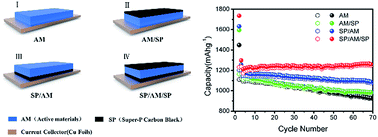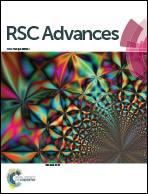Superior cycling performance of a sandwich structure Si/C anode for lithium ion batteries†
Abstract
Silicon, as a next generation anode material, suffers from low electronic conductivity and large volume changes during the lithiation/delithiation process, resulting in very large capacity fading upon cycling. Herein, we design a novel sandwich-structured Si/C electrode formed between two conductive carbon layers. In this configuration, the bottom carbon layer functions as a buffer layer to increase the adhesion to the Cu foil and to avoid peeling-off of the active materials, whereas the top carbon layer on the electrolyte side serves as a barrier layer to prevent the electrode surface from cracking and delaminating. As expected, the sandwich-structured Si/C electrode delivers a high reversible capacity of 1230 mA h g−1 at current density of 150 mA g−1 and exhibits excellent cycling stability without obvious capacity decay after 70 cycles. This simple and effective design would be a promising approach to obtain high performance and cost-effective Si anodes on a large-scale, especially for industrial manufacturing of high energy density Li-ion batteries.


 Please wait while we load your content...
Please wait while we load your content...